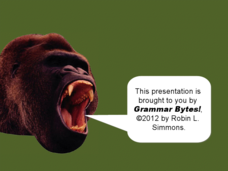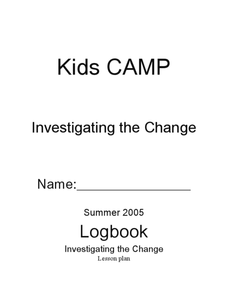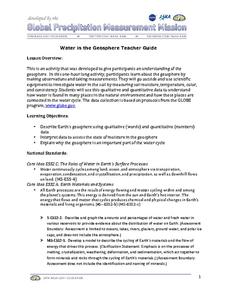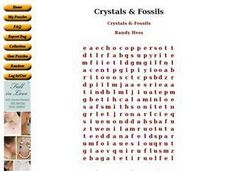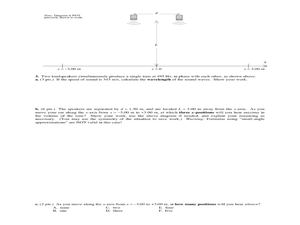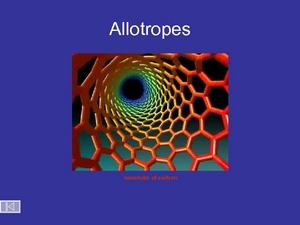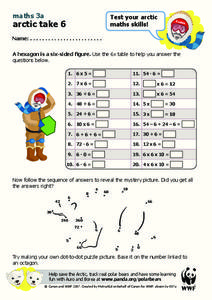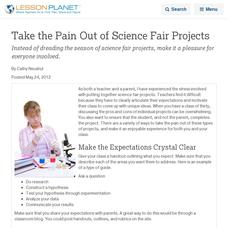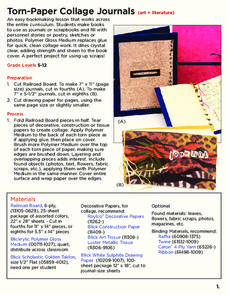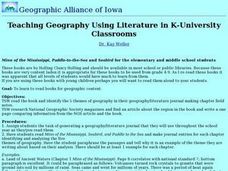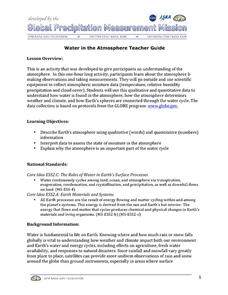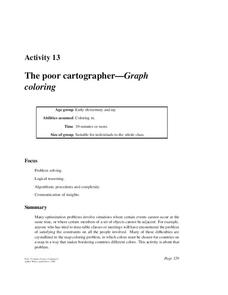Curated OER
Igneous Rocks
High schoolers focus on a study of igneous rocks. They see how igneous rocks are formed, and how to distinguish them from other types of rocks. A crystal-growing activity is present, and learners create drawings that show where each...
Curated OER
Pronoun Case
Whether viewed as a whole class, or individually, this PowerPoint is a fabulous resource for teaching and reinforcing the rules of pronouns. There are 22 slides total; the first nine explain the differences between subjective, objective,...
Curated OER
Investigating the Change
Sugar crystal growth is observed as an example of physical change and cabbage juice pH indicator is used to demonstrate chemical change. The crystal growth is tracked over five days. The cabbage juice experiment is involved and can also...
Curated OER
Solar Electricity ~ The Colour Sensitivity of a Photovoltaic Cell
Teacher's notes, a materials list, detailed procedure, tips, and extension ideas are all included to make teaching this instructional activity on photovoltaic cells a sunny spot in your day! After some brief background reading, physical...
Curated OER
Water in the Geosphere
Through a PowerPoint presentation and the embedded animation and video, earth science enthusiasts find out about the moisture in the soil beneath our feet. In the animation, follow a water molecule on its path through the water cycle. As...
Curated OER
Chemistry Module
Students build metal atomic models using styrofoam. In this chemistry lesson, students identify the different unique properties of metals. They explain how metal atoms bond.
Curated OER
Ellie's Diary 1 The Future Tense
In this reading worksheet, students read a diary entry for information and answer comprehension questions. In this short answer worksheet, students answer eleven questions.
Curated OER
Crystals & Fossils
In this earth science worksheet, students identify and locate vocabulary terms related to crystals and fossils. There are 32 words located in the puzzle.
Curated OER
Typical Numeric Questions for Physics I - Electric Fields and Potential
Challenge your physics class to implement their knowledge of electric fields by completing this worksheet as homework. There are 15 problems to solve, for which pupils compute electrostatic force, electric field strength, and electric...
Baylor College
What Is a One Part Per Million Solution?
Water may appear to be crystal clear, but there could be dissolved substances present. Lab groups make a one-part-per-million of a food coloring solution to demonstrate this concept. As part of an outstanding unit about water, this...
Curated OER
Physics Midterm Exam #3 - Electromagnetic Radiation
True-false and multiple-choice questions are posed in Part A of this exam, covering the topic of electromagnetic radiation. In Part B, problems relating to refraction must be solved. This is a well-rounded exam that will help you...
Curated OER
Allotropes
Brilliant graphics depict a variety of allotropes, especially the allotropes of carbon. Some notes are available to help make these useful for teaching your young chemists, but not for every slide. With some additional preparation on...
Curated OER
Unit 3 Bonding
An organized table charting the different types of chemical bonds arrays this resource. The octet rule, ionization energy, and the naming of compounds are also reviewed. Young chemists answer review questions in multiple choice fashion....
World Wildlife Fund
Arctic Take 6
The magic number is six! Using a 6x table, young math stars practice adding, subtracting, multiplying, and dividing two-digit numbers with the number six. This learning exercise also touches on making tessellations with hexagons.
Curated OER
Take the Pain Out of Science Fair Projects
Instead of dreading the season of science fair projects, make it a pleasure for everyone involved.
K12 Reader
Improve Your Writing with Similes
A language arts worksheet works like a dream. Class members become as busy as bees as they complete a activity geared toward similes. The layout of the sheet is as clear as crystal, with directions that are easy to follow.
Dick Blick Art Materials
Torn-Paper Collage Journals
Young writers personalize their journals by making their own. Whether they make covers for existing journals or make their own books, the activity encourages kids to express themselves in words and images.
Curated OER
Drip... Drop... Raindrops
Students demonstrate the steps of evaporation, cloud formation, and precipitation within the water cycle. They make and demonstrate how to use a hygrometer to record daily humidity and describe how rain, snow, and sleet form.
Curated OER
teaching Geography Using Literature in K-University Classrooms
Students read one of the following books: Minn of the Mississippi, Paddle-to-the-Sea, or Seabird, all by Holling C. Holling, and identify the five themes of geography as well as make a literature journal with chapter field notes. They...
Curated OER
Evidence of Photosynthesis
Hands on science is the way to go! Learners conduct a lab experiment to help them explain how plants make food through photosynthesis. They test for the presence of starch in leaves using iodine solution and identify the basic things...
Curated OER
Aboriginal Hand Prints
A part of a study of Australian Aboriginal culture, class members listen to a Dreamtime story about a father who stenciled his handprint on a rock wall. Class members then make their own hand print art representative of themselves...
Curated OER
Water in the Atmosphere
A slide show serves as the backdrop for a lesson on the moisture in Earth's atmosphere. Through it, mini meteorologists learn about the attributes of the atmosphere and actually use data-collecting weather tools to make observations and...
Curated OER
Weather Challenge
For this identifying the weather terms activity, students read phrases about the weather and choose the term being described. Students choose 11 multiple choice answers.
Computer Science Unplugged
The Poor Cartographer—Graph Coloring
Color the town red. Demonstrate the concept of graph theory with a task that involves determining the least number of colors needed to color a map so that neighboring countries are not represented by the same color. Pupils...
Other popular searches
- Making Crystals Experiments
- Making Crystals in Math
- Recipe for Making Crystals
- Making Crystals in Gel

